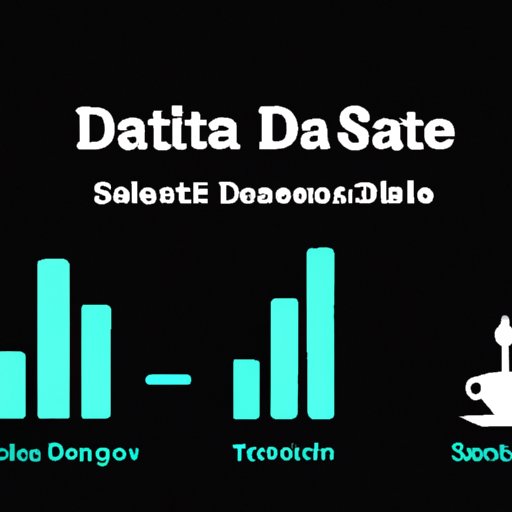Introduction
Data science is a rapidly growing field that combines programming, mathematics, and business skills to extract knowledge from large datasets. It has become increasingly popular over the past decade due to the emergence of Big Data and the need for companies to analyze this data in order to make informed decisions. In recent years, the data science market has become oversaturated with professionals, programs, and startups, making it difficult for newcomers to break into the field. This article will explore the job market for data science professionals, examine the overcrowded landscape of data science programs, investigate the impact of automation on data science jobs, and assess the long-term implications of an oversaturated data science market.

Analyzing the Job Market for Data Science Professionals
The job market for data science professionals has grown significantly since the emergence of Big Data. According to the US Bureau of Labor Statistics, employment of computer and information research scientists is projected to grow 16% from 2019 to 2029, much faster than the average for all occupations. Furthermore, a recent survey by O’Reilly found that the annual median salary for data science professionals is $120,000, with experienced professionals earning up to $200,000. This is significantly higher than the median salary for other professions such as software engineering ($105,000) and web development ($82,500).
In addition to the growth in salaries, the number of companies hiring data scientists has also increased. Companies such as Google, Amazon, Microsoft, and IBM have invested heavily in data science initiatives, creating thousands of new positions. According to a report by McKinsey & Company, the demand for data science professionals is expected to outpace the supply by more than 50% in the next four years.
Examining the Overcrowded Landscape of Data Science Programs
As the demand for data science professionals has grown, so has the number of programs offering data science degrees and certifications. There are now hundreds of online and on-campus programs available, ranging from short-term bootcamps to full-time master’s degrees. The cost of these programs can vary significantly, with some programs costing upwards of $50,000. However, many programs are now offering scholarships and financial aid to help offset the cost.
It is important to note that not all data science programs are created equal. Many programs lack the necessary resources and faculty to adequately prepare students for the job market. It is important to research each program carefully before enrolling to ensure that it is of high quality and provides the best chance of success in the field.

Exploring the Rapid Growth of Data Science Startups
The rapid growth of data science startups has had a significant impact on the traditional job market. Startups such as Palantir, Databricks, and Cloudera have become major players in the industry, creating thousands of new jobs and offering competitive salaries. For many data science professionals, working in a startup can provide a unique opportunity to work on cutting-edge technology and have a direct impact on the company’s success.
However, there are also challenges associated with working in a startup. Startups often require long hours and may not offer the same level of job security as larger companies. Additionally, startups often require employees to wear multiple hats and be comfortable with change and uncertainty.

Investigating the Impact of Automation on Data Science Jobs
Automation is having a profound impact on the data science job market. With the rise of machine learning and artificial intelligence, many tasks that were once performed by humans are now being automated. This has led to increased efficiency and reduced costs for businesses, but it has also had an impact on the number of available jobs for data science professionals.
While automation has replaced some human labor, it has also created new opportunities for data science professionals. Automation requires specialized skills such as programming and machine learning, which are in high demand. As such, data science professionals who possess these skills can benefit from the growth of automation.
Assessing the Long-Term Implications of an Oversaturated Data Science Market
The rapid growth of the data science market has had both positive and negative implications. On one hand, it has resulted in increased salaries, more job opportunities, and better access to education. On the other hand, it has created an oversaturated market with intense competition and lower salaries in the long term.
The most immediate implication of an oversaturated market is a decrease in salaries. As more people enter the field, employers are able to offer lower salaries for the same positions. Furthermore, the influx of new professionals has made it more difficult for those without experience to break into the field. This has resulted in increased competition for entry-level jobs and higher barriers to entry for those without prior experience.
Conclusion
The data science market has grown exponentially over the past decade, resulting in an oversaturated market with intense competition and decreased salaries. Despite this, there are still many opportunities for data science professionals. Those with specialized skills and experience in automation can benefit from the growth of machine learning and artificial intelligence, while those looking to break into the field should take advantage of scholarship and financial aid programs in order to reduce the cost of education.
Overall, the data science market is an ever-changing landscape that requires continual adjustment in order to remain competitive. By understanding the current state of the market and taking advantage of available resources, data science professionals can navigate the oversaturated market and find success.
(Note: Is this article not meeting your expectations? Do you have knowledge or insights to share? Unlock new opportunities and expand your reach by joining our authors team. Click Registration to join us and share your expertise with our readers.)
